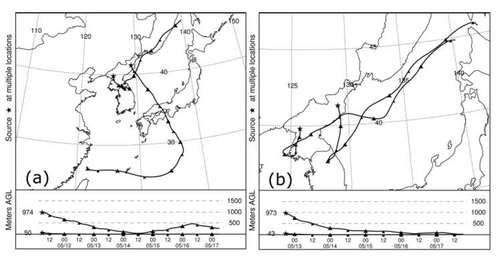
This issue of the journal continues the debate about whether North Korea may have carried out one or more low-yield nuclear tests in May 2010 with an important contribution by Christopher Wright in "Low-yield Nuclear Testing by North Korea in April/May 2010: Assessing the Evidence with Atmospheric Transport Models and Xenon Activity Calculations" (Free PDF of the article) Wright adds to the work reported in two previous issues of this journal and fills in some important parts of the puzzle.
Lars-Erik De Geer first used radionuclide signals detected in South Korea, Japan and Russia to suggest the possibility of one or two undeclared North Korean nuclear tests in 2010 ("Radionuclide Evidence for Low-Yield Nuclear Testing in North Korea in April/May 2010," volume 20, number 1, 2012). David P. Schaff, Won-Young Kim, and Paul G. Richards analyzed seismic signals recorded in northeastern China around the time of the proposed test(s) to argue that no well-coupled underground explosion with yield above about one ton TNT equivalent took place at or near the North Korea test site on the suggested dates ("Seismological Constraints on Proposed Low-Yield Nuclear Testing in Particular Regions and Time Periods in the Past, with Comments on "Radionuclide Evidence for Low-Yield Nuclear Testing in North Korea in April/May 2010" by Lars-Erik De Geer," volume 20, numbers 2&3, 2012).
Wright assesses the possibility that the observed radionuclides may have had a non-explosive source and may have originated at nuclear facilities in North Korea, South Korea, Japan, Russia, China or Taiwan. The paper uses forward and backward atmospheric transport modeling to produce possible radionuclide trajectories and plume concentrations, as well as activity calculations of both reactor and explosion-produced xenon to determine possible source terms. The results appear to be consistent with a small, uncontained North Korean nuclear test on 11 May 2010. The implication is that national radionuclide monitoring stations and the International Monitoring System of the Comprehensive Test Ban Treaty combined with publicly available atmospheric transport and source modeling capabilities are capable of detecting and identifying even a small, seismically decoupled nuclear test in North East Asia.
Robert Alvarez unearths the troubled history of uranium-233 as part of the military and civilian nuclear programs of the United States, its use as weapon material in a number of nuclear tests between 1955 and 1968, the failed efforts to use it as a reactor fuel, and the long-standing problems of accounting for and disposing of what remains of the two tons that were produced. In "Managing the Uranium-233 Stockpile of the United States," Alvarez reveals the persistent failure by the U.S. Department of Energy to secure safely the about 800 kg of uranium-233 it has in storage (another almost 100 kg of uranium-233 may be unaccounted for).
The 1980 international Convention on the Physical Protection of Nuclear Material mandates special security measures for 2 kg or more of uranium-233, including "specific measures [for] the detection and prevention of any assault, unauthorized access or unauthorized removal of material." There are similar U.S. national standards. Alvarez recommends that given such security concerns, the U.S. Department of Energy reconsider its plans to dispose of about 100 kg of uranium-233 diluted with 800 kg of uranium-235 as landfill at the Nevada National Security Site (the former nuclear weapons test site).
Uncovering the history of the production of highly enriched uranium for weapons is the challenge taken up by Matthew Sharp in "Applications and Limitations of Nuclear Archaeology in Uranium Enrichment Plants." Independently reconstructing and verifying the production history of highly enriched uranium may be key to building confidence in nuclear weapon and fissile material stockpile declarations and thus the nuclear disarmament process. Sharp's paper applies the insight that while production of highly enriched uranium exploits the small mass difference between uranium-235 and uranium-238 (0.7% and 99.3% respectively of natural uranium), uranium-234 is also present at levels of about 0.005% in natural uranium.
Sharp's paper shows how measurements of uranium-234 in an enrichment plant's depleted uranium waste or tails can generate constraints on the concentration of uranium-235 and amount of enriched product from the plant. He suggests independent confirmation, or at least consistency checks, of the declared production history of a simple uranium enrichment plant (with one source of feed material, one product stream, and largely intact tails) may be possible even in the face of efforts at diversion of material and concealment of the true production history. Such nuclear archaeology methods may have more limited utility for the far more complex enrichment programs of the United States and Soviet Union for making highly enriched uranium for weapons during the Cold War. Nonetheless, Sharp makes an important case for nuclear weapons states preserving the depleted uranium tails and operating records from their military enrichment plants to permit future measurements that could help verify declarations of historical fissile material production.
